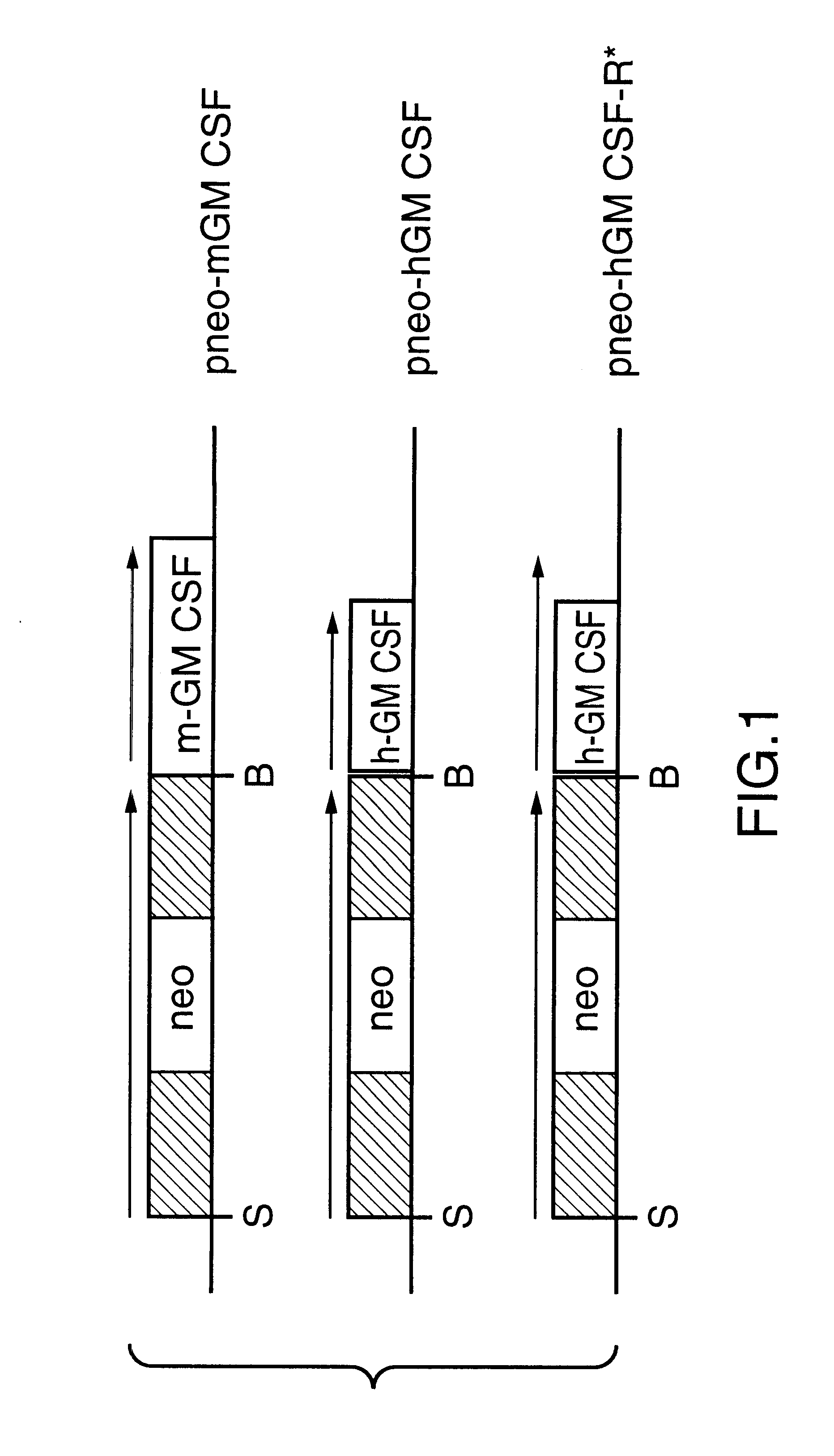Macrophage-infecting parasites expressing a granulocyte macrophage colony stimulating factor
a technology of colony stimulating factor and macrophage, which is applied in the field of macrophage-infecting parasites expressing granulocyte macrophage colony stimulating factor, can solve the problems of not being able to induce the elimination of parasites in infected macrophages, and the viability of amastigotes inside murine or human macrophages is greatly reduced, so as to reduce the viability of amastigotes, the anti-leishmania effect of gm
- Summary
- Abstract
- Description
- Claims
- Application Information
AI Technical Summary
Benefits of technology
Problems solved by technology
Method used
Image
Examples
example 1
This Example describes techniques of recombinant DNA.
Leishmania vector pneo-mGM CSF expressing the mrurine-GM-CSF gene was made as follows. A 1.2 kb KpnI-KpnI fragment isolated from plasmid pXMT2 containing the MGM-CSF gene and flanking sequences was filled in with T4 DNA polymerase (New England Biolabs) to create blunt ends and subcloned into the BamHI site of vector pSP72-.alpha.neo.alpha. filled in with Klenow DNA polymerase (New England Biolabs). Vector pSP72-.alpha.neo.alpha. was generated by subcloning the 2.6 kb BamHI-SmaI neo-cassette from pGEM3-neo (ref. 23) containing the neo gene flanked by the intergeniLc regions of the .gamma.-tubulin gene of L. enriettii (ref. 21) into the BamHI-SmaI of pSP72 kPrormega). The Leishmania construct to express the human GM-CSF gene was made by subcloning an 800 bp XhoI-XhoI fragment from vector PXMT1 containing the hGM-CSF gene and flanking sequences into the SalI site of pSP72-.alpha.neo.alpha. to yield pneo-hGM CSF. Construct pneo-hGM CS...
example 2
This Example describes the culturing and transfection of Leishmania.
Leishmania major MHOM / IL / 67 / JERICHO II; and Leishmania donovani donovani MHOM / IN / 80 / DD8 are WPAIR / WHO reference strains obtained from the ATCC. All strains were grown in SDM-79 medium (ref. 22) supplemented with 10% fetal bovine serum (FBS) (Multicell, Wisent Inc.) and 5 .mu.g / ml of hemin. Approximately 15 .mu.g of pneo-GM CSF vector DNA was used to transfect L. donovani and L. major cells by electroporation as described (refs. 23, 24). Transfectants were selected with 40 .mu.g / ml of G-418 (Ceneticin, Gibco-BRL). Leishmania-GM CSF and control Leishmania-pneo transfectants were seeded at low concentration (3.times.10.sup.4 cells per culture dish) in 5 ml of SDM-79 medium. After 72 hours the cell density was obtained by measuring the absorbance at 600 nm using an automated microplate reader (Reader 510 from Organon Tecknika Inc., Austria). Murine macrophage cell line J774, obtained from ATCC, was cultured in Dulbecco'...
example 3
This Example describes in vitro macrophage infection.
The capacity of Leishmania-GM CSF transfectants to infect murine and human macrophages in vitro was tested in comparison to control Leishmania-pneo as follows. Murine and human macrophages were seeded (200 .mu.l per well, 5.times.10.sup.4 cells / ml) into 8 wells chamber slides, and were infected with L. major-pneo and L. major-GM CSF at a parasite to cell ratio of 20:1 for a period of 6 hours. Following this incubation, non-engulfed parasites were removed by 3 to 5 washes with warm medium and chambers were replenished with 500 .mu.l of fresh culture medium. The level of infection was determined at 6, 24, 48, and 72 hours by optical microscopy examination following Diff Quick staining of cell preparations.
PUM
| Property | Measurement | Unit |
|---|---|---|
| concentration | aaaaa | aaaaa |
| immunogenic composition | aaaaa | aaaaa |
| resistance | aaaaa | aaaaa |
Abstract
Description
Claims
Application Information
 Login to View More
Login to View More - R&D
- Intellectual Property
- Life Sciences
- Materials
- Tech Scout
- Unparalleled Data Quality
- Higher Quality Content
- 60% Fewer Hallucinations
Browse by: Latest US Patents, China's latest patents, Technical Efficacy Thesaurus, Application Domain, Technology Topic, Popular Technical Reports.
© 2025 PatSnap. All rights reserved.Legal|Privacy policy|Modern Slavery Act Transparency Statement|Sitemap|About US| Contact US: help@patsnap.com

